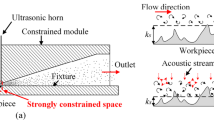Abstract
In this paper, a novel polishing method, submerged air jet polishing (SAJP), is proposed. In this method, the nozzle and workpiece are completely immersed in the abrasive fluid. When the compressed air is sprayed from the nozzle in the abrasive fluid at high velocity onto the workpiece surface, the material removal occurs on the workpiece surface due to abrasive contact and cavitation. The main finding of this paper is to establish the microscopic theoretical model of SAJP on the basis of the micro-cutting model of the single abrasive particle. The erosion removal mechanism of SAJP processing titanium alloy was studied by simulation combined with experiments, and the material removal mechanism under different process parameters was explored from the perspective of microscopic evolution.


















Similar content being viewed by others
Availability of data and material
The datasets analyzed during the current study are available from the corresponding author on reasonable request.
Code availability
Not applicable.
References
Qiang ZR, Miao XJ, Wu MP, Sawhney R (2018) Optimization of abrasive waterjet machining using multi-objective cuckoo search algorithm. Int J Adv Manuf Technol 99(5–8):1257–1266
Beaucamp A, Namba Y, Messelink W, Messelink W, Walker D, Charlton P, Freeman R (2014) Surface integrity of fluid jet polished tungsten carbide. 2nd CIRP Conf Surf Integr 13:377–381
Li QL, Deng YF, Li J, Shi WT (2020) Roughness characterization and formation mechanism of abrasive air jet micromachining surface studied by power spectral density. J Manuf Process 57:737–747
Fan JM, Wang CY, Wang J (2009) Modelling the erosion rate in micro abrasive air jet machining of glasses. Wear 266(9):968–974
Li QL (2014) Surface roughness analysis on micro abrasive air jet forming technology. Mechanical Engineer 12:7–9
Karpuschewski B, Emmer T, Schmidt K, Petzel M (2013) Cryogenic wet-ice blasting-Process conditions and possibilities. CIRP Ann Manuf Technol 62(1):319–322
Zhang FH, Kang GW, Qiu ZJ, Dong S (2004) Magnetorheological finishing of glass ceramic. Key Eng Mater 257–258:511–514
Kim WB, Nam E, Min BK, Choi DS, Je TJ, Jeon EC (2015) Material removal of glass by magnetorheological fluid jet. Int J Precis Eng Manuf 16(4):629–637
Beaucamp A, Katsuura T, Kawara Z (2017) A novel ultrasonic cavitation assisted fluid jet polishing system. CIRP Ann Manuf Technol 66(1):301–304
Beaucamp A, Katsuura T, Takata K (2018) Process mechanism in ultrasonic cavitation assisted fluid jet polishing. CIRP Ann Manuf Technol 67(1):361–364
Su YT, Wang SY, Chao PY, Hwang YD, Hsiau JS (1995) Investigation of elastic emission machining process-lubrication effects. Precision Eng J Am Soc Precision Eng 17(3):164–172
Peng WQ, Li SY, Guan CL, Shen XM, Dai YF, Wang Z (2013) Improvement of magnetorheological finishing surface quality by nanoparticle jet polishing. Opt Eng 52(4)
Chen FJ, Wang H, Tang Y, Yin SH, Huang S, Zhang GH (2018) Novel cavitation fluid jet polishing process based on negative pressure effects. Ultrason Sonochem 42:339–346
Zhao J, Xiang YC, Fan C (2022) A new method for polishing the inner wall of a circular tube with a soft abrasive rotating jet. Powder Technol 398:117068
Finnie I (1960) Erosion of surfaces by solid particles. Wear 3:87–103
Funding
This research was funded by the Natural Science Foundation of Jiangsu Province (grant no. BK20201412), the Natural Science Foundation of the Jiangsu Higher Education Institutions of China (grant no. 19KJA220001), and the National Natural Science Foundation of China (grant no. 51975392, 51775360).
Author information
Authors and Affiliations
Contributions
Investigation, Chen Ding, and Wei Chen; project administration, Lei Zhang; validation, Cheng Fan; writing—original draft, Cheng Fan and Wei Chen; writing—review and editing, Lei Zhang. All authors read and approved the final manuscript.
Corresponding author
Ethics declarations
Ethics approval
Not applicable.
Consent to participate
Not applicable.
Consent for publication
Not applicable.
Conflict of interest
The authors declare no competing interests.
Additional information
Publisher's Note
Springer Nature remains neutral with regard to jurisdictional claims in published maps and institutional affiliations.
Rights and permissions
Springer Nature or its licensor holds exclusive rights to this article under a publishing agreement with the author(s) or other rightsholder(s); author self-archiving of the accepted manuscript version of this article is solely governed by the terms of such publishing agreement and applicable law.
About this article
Cite this article
Zhang, L., Chen, W., Ding, C. et al. Removal mechanism of submerged air jet polishing considering the state of abrasive particles. Int J Adv Manuf Technol 122, 4099–4114 (2022). https://doi.org/10.1007/s00170-022-10116-3
Received:
Accepted:
Published:
Issue Date:
DOI: https://doi.org/10.1007/s00170-022-10116-3




